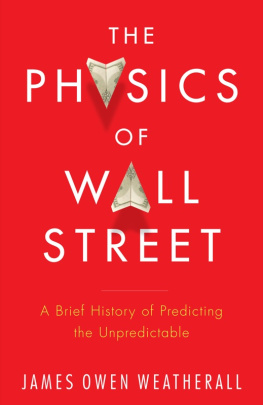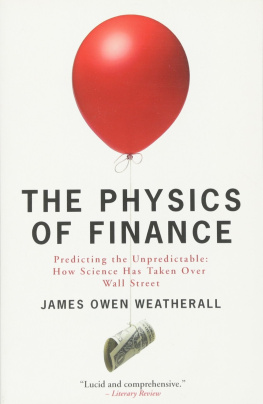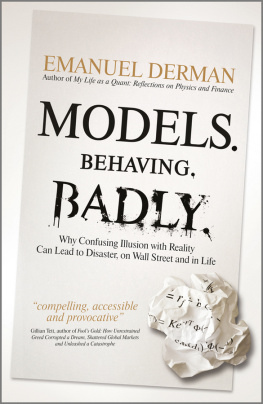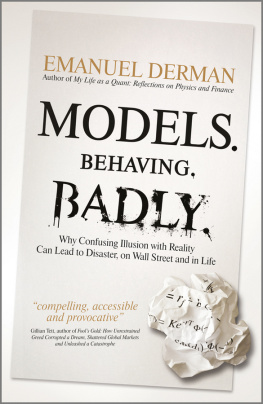
Scribe Publications
THE PHYSICS OF WALL STREET
James Owen Weatherall is a physicist, philosopher, and mathematician. He holds graduate degrees from Harvard, the Stevens Institute of Technology, and the University of California, Irvine, where he is presently an assistant professor of logic and philosophy of science. He has written for Slate and Scientific American . He lives in Irvine, California.
Scribe Publications Pty Ltd
1820 Edward St, Brunswick, Victoria, Australia 3056
Email: info@scribepub.com.au
First published in the United States by Houghton Mifflin Harcourt Publishing Company
Published in Australia and New Zealand by Scribe 2013
Copyright James Owen Weatherall 2013
All rights reserved. Without limiting the rights under copyright reserved above, no part of this publication may be reproduced, stored in or introduced into a retrieval system, or transmitted, in any form or by any means (electronic, mechanical, photocopying, recording or otherwise) without the prior written permission of the publishers of this book.
National Library of Australia
Cataloguing-in-Publication data
Weatherall, James Owen.
The Physics of Wall Street: a brief history of predicting the unpredictable.
9781922072252 (e-book.)
Includes bibliographical references.
1. Mathematical physics. 2. Finance. 3. Economics.
530.1
www.scribepublications.com.au
To Cailin
Contents
: Of Quants and Other Demons
: Send Physics, Math, and Money!
Introduction: Of Quants and Other Demons
W ARREN B UFFETT ISNT the best money manager in the world. Neither is George Soros or Bill Gross. Th e worlds best money manager is a man youve probably never heard of unless youre a physicist, in which case youd know his name immediately. Jim Simons is co-inventor of a brilliant piece of mathematics called the Chern-Simons 3-form, one of the most important parts of string theory. Its abstract, even abstruse, stuff some say too abstract and speculative but it has turned Simons into a living legend. Hes the kind of scientist whose name is uttered in hushed tones in the physics departments of Harvard and Princeton.
Simons cuts a professorial figure, with thin white hair and a scraggly beard. In his rare public appearances, he usually wears a rumpled shirt and sports jacket a far cry from the crisp suits and ties worn by most elite traders. He rarely wears socks. His contributions to physics and mathematics are as theoretical as could be, with a focus on classifying the features of complex geometrical shapes. Its hard to even call him a numbers guy once you reach his level of abstraction, numbers, or anything else that resembles traditional mathematics, are a distant memory. He is not someone you would expect to find wading into the turbulent waters of hedge fund management.
And yet, there he is, the founder of the extraordinarily successful firm Renaissance Technologies. Simons created Renaissances signature fund in 1988, with another mathematician named James Ax. Th ey called it Medallion, after the prestigious mathematics prizes that Ax and Simons had won in the sixties and seventies. Over the next decade, the fund earned an unparalleled 2,478.6% return, blowing every other hedge fund in the world out of the water. To give a sense of how extraordinary this is, George Soross Quantum Fund, the next most successful fund during this time, earned a mere 1,710.1% over the same period. Medallions success didnt let up in the next decade, either over the lifetime of the fund, Medallions returns have averaged almost 40% a year, after fees that are twice as high as the industry average. (Compare this to Berkshire Hathaway, which averaged a 20% return from when Buffett turned it into an investment firm in 1967 until 2010.) Today Simons is one of the wealthiest men in the world. According to the 2011 Forbes ranking, his net worth is $10.6 billion, a figure that puts Simonss checking account in the same range as that of some high-powered investment firms.
Renaissance employs about two hundred people, mostly at the companys fortresslike headquarters in the Long Island town of East Setauket. A third of them have PhDs not in finance, but rather, like Simons, in fields like physics, mathematics, and statistics. According to MIT mathematician Isadore Singer, Renaissance is the best physics and mathematics department in the world which, say Simons and others, is why the firm has excelled. Indeed, Renaissance avoids hiring anyone with even the slightest whiff of Wall Street bona fides. PhDs in finance need not apply; nor should traders who got their start at traditional investment banks or even other hedge funds. Th e secret to Simonss success has been steering clear of the financial experts. And rightly so. According to the financial experts, people like Simons shouldnt exist. Th eoretically speaking, hes done the impossible. Hes predicted the unpredictable, and made a fortune doing it.
Hedge funds are supposed to work by creating counterbalanced portfolios. Th e simplest version of the idea is to buy one asset while simultaneously selling another asset as a kind of insurance policy. Often, one of these assets is what is known as a derivative. Derivatives are contracts based on some other kind of security, such as stocks, bonds, or commodities. For instance, one kind of derivative is called a futures contract. If you buy a futures contract on, say, grain, you are agreeing to buy the grain at some fixed future time, for a price that you settle on now. Th e value of a grain future depends on the value of grain if the price of grain goes up, then the value of your grain futures should go up too, since the price of buying grain and holding it for a while should also go up. If grain prices drop, however, you may be stuck with a contract that commits you to paying more than the market price of grain when the futures contract expires. In many cases (though not all), there is no actual grain exchanged when the contract expires; instead, you simply exchange cash corresponding to the discrepancy between the price you agreed to pay and the current market price.
Derivatives have gotten a lot of attention recently, most of it negative. But they arent new. Th ey have been around for at least four thousand years, as testified by clay tablets found in ancient Mesopotamia (modern-day Iraq) that recorded early futures contracts. Th e purpose of such contracts is simple: they reduce uncertainty. Suppose that Anum-pisha and Namran-sharur, two sons of Siniddianam, are Sumerian grain farmers. Th ey are trying to decide whether they should plant their fields with barley, or perhaps grow wheat instead. Meanwhile, the priestess Iltani knows that she will require barley next autumn, but she also knows that barley prices can fluctuate unpredictably. On a hot tip from a local merchant, Anum-pisha and Namran-sharur approach Iltani and suggest that she buy a futures contract on their barley; they agree to sell Iltani a fixed amount of barley for a prenegotiated price, after the harvest. Th at way, Anum-pisha and Namran-sharur can confidently plant barley, since they have already found a buyer. Iltani, meanwhile, knows that she will be able to acquire sufficient amounts of barley at a fixed price. In this case, the derivative reduces the sellers risk of producing the goods in the first place, and at the same time, it shields the purchaser from unexpected variations in price. Of course, theres always a risk that the sons of Siniddianam wont be able to deliver what if there is a drought or a blight? in which case they would likely have to buy the grain from someone else and sell it to Iltani at the predetermined rate.
Hedge funds use derivatives in much the same way as ancient Mesopotamians. Buying stock and selling stock market futures is like planting barley and selling barley futures. Th e futures provide a kind of insurance against the stock losing value.
Next page







